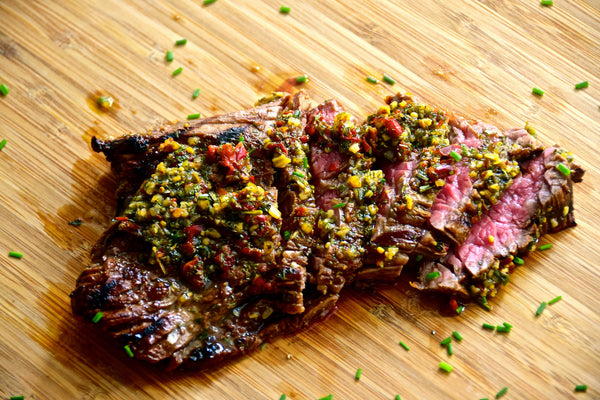
Whether you’re dining out or eating in, there is probably one cut of beef that you go for every time. There’s one favorite that gets you excited. You plan your special meals around it. It makes your mouth water. Chances are, you’re thinking of it right now. It’s easy to lean on your go-to favorite steak or roast for every occasion. You know it’s fantastic, you know you love it, so why risk trying something else?
But when it comes to Wagyu beef, particularly 100% Fullblood Wagyu beef, there’s some magic in all the varieties of cuts. You might be pleasantly surprised when you explore outside your culinary comfort zone. Consider this your comprehensive guide to the exquisite qualities of the other cuts of Wagyu beef.
All about beef
So, the question is, what makes all of these different cuts of steak different and unique? It comes down to where each cut comes from.
Understanding a little bit more about what beef is and the various cooking methods will help us in our quest to learn more about the different cuts. Beef is essentially muscle tissue from a cow. Different cuts of meat come from different parts of the animal. What really makes them different is how each of these muscles is used.
Muscles that are used regularly are stronger and thus tougher, and they need to be cooked for longer periods of time and much slower in order to loosen out the connective tissue. Slow cooking methods can include stewing, boiling and braising. The muscles that are not used as much should be prepared using dry heat methods such as grilling, roasting, sautéing and broiling.
With that in mind, this series of 3 blog posts will take a look at some of the different cuts of beef, what makes each one special, how they can be best prepared, and how Wagyu characteristics influence the taste, tenderness, and quality. We’ll start with some of the most popular types of steaks.
Filet or Tenderloin Steak

Image: Lone Mountain Wagyu 100% Fullblood Wagyu Filet Mignon
The filet (Filet Mignon) is without a doubt one of the most sought after cuts in restaurants around the world. It’s more expensive than any other cut and many would argue it is unbeatable in terms of mouthfeel and tenderness. This cut comes from the tenderloin area of the cow which is not worked very hard, making it a very tender and lean cut of beef. In addition to its prized tenderness, Filet Mignon comes in a precious limited supply. Typically, the yield of tenderloin is as small as 10 to 12 pounds total per animal.
The filet has a sweet flavor and delicate tenderness. Because this muscle is mostly sedentary, it is very supple. In Wagyu, particularly 100% Fullblood Wagyu, the Filet Mignon has more marbling, bringing even more velvety decadence and flavor than Filet Mignon cuts from other breeds of cattle.
Other cuts from the same area, the tenderloin, are known as Chateaubriand, Tournedos, or Medallions depending what part of the world you are in.
Filet Mignon is prepared in many different ways, but to get the most from this cut you should use a dry heat method of cooking. Most prefer to grill or sauté this cut using a very hot pan. Filets especially should not be cooked past Medium Rare, to best exhibit the tenderness the cut is known for.
Top Sirloin
Image: Lone Mountain Wagyu 100% Fullblood Wagyu Top Sirloin
Located at the back end of the cow, the sirloin is divided into Top Sirloin and Bottom Sirloin. This evokes their respective location - the bottom sirloin is below the top. The Top Sirloin is considered a leaner cut that offers good flavor and moderate tenderness. Top Sirloin doesn’t exhibit the premium attributes of Wagyu such as intense marbling as well as some others.
Top Sirloin steaks are versatile and tend to be cooked by frying or grilling, broiled or roasted. One that's grill-ready is about 1.5 inches thick and has a layer of fat around the edge. If roasting, make sure to cut the fat. If grilled, the steak has a rounded appearance.This is a very popular cut as it is still quite lean but doesn’t carry the same price tag as the filet.
Skirt Steak

Image: Lone Mountain Wagyu 100% Fullblood Wagyu Inside Skirt Steak
Located just underneath the rib towards the belly of the cow and part of the diaphragm, the Skirt Steak has gained popularity. This boneless cut is most appreciated for its flavor, but when prepared correctly the skirt also offers a tender bite. In Wagyu, the skirt can become quite marbled, imparting a soft texture that bursts with flavor.
Skirt Steak is a long and mostly thin cut of beef with very dynamic, long grains of muscle tissue. When marinated, particularly with an abrasive liquid like a vinegar, Worcestershire, or soy, the longer, tougher muscle fibers break down slightly. When this thin, marinated meat is cooked on very high heat for short amount of time it becomes quite tender. The steak itself generally offers a variance in thickness, with tails ends thin as paper and a center up to 1-1 ½” thick. This creates a dynamic flavor when prepared, with both medium rare full-bodied, flavorful meat and caramelized crispy edges.
Skirt Steak is great when marinated and placed on the grill, roasted, or sautéed for more complex Asian or Mexican recipes. The best way to know a good piece of skirt steak is its flexibility; it shouldn't have a tough feel or seem rigid. Cutting against the grain of the skirt is another way to preserve the juices and make it even more tender.
Ribeye

Image: Lone Mountain Wagyu 100% Fullblood Wagyu Ribeyes
With the Ribeye, it’s all in the name. This cut of meat comes from the rib of the cow. The rib cage is little used for movement and doesn’t bear much weight, making the ribeye well marbled and tender with a layer of fat surrounding the cut. When this fat melts during cooking, the flavor is spread throughout the meat, bringing dynamic flavor to every bite. Wagyu Ribeyes tend to be intensely marbled, epitomizing the desired traits of the cut. The Ribeye is the section of the cow that is evaluated to determine its grade (Prime, A4, etc).
Ribeyes can be served with the bone removed or left in, depending on the restaurants or butchers preference. It’s often referred to as the ‘beefiest’ steak available.
The secret to cooking a good Ribeye in a pan or on the grill is to quickly sear it at high heat to seal and then move to lower heat to continue cooking and release all the flavor.
Strip Steak

Image: Lone Mountain Wagyu 100% Fullblood Wagyu Strip Steak
The Strip Steak, commonly referred to as a New York Strip, comes from the short loin and is one of the most popular cuts of steak in the country. The Strip is actually part of the T-Bone, or Porterhouse Steak, both which include the strip and tenderloin on either side of the bone. As strips, the steaks are served boneless.
On the spectrum of fat content, Strip Steaks are intermediate, falling between a tenderloin and a ribeye for a balanced experience of flavor and texture. In Wagyu, the Strip can house some of the most dense and delicate veins of marbling, exaggerating the already prevalent qualities and making it one of the best cuts of Wagyu beef.
Strip Steaks are the perfect choice for the grill, given their relatively lower fat content, parts of which can be easily trimmed. Removing excess fat on the outside of the cut (not the marbling throughout!) reduces the chance of flare-ups while grilling.
To cook Strip Steak it is best to cook it quickly over a high heat. Grill, pan-fry, or broil for best results. Remember with Strip Steak, the key is to keep it simple. Add spices or a sauce but the important thing is to make sure this great cut shines.
Hanger Steak

Image: Flickr by Creative Roger
Cut from the lower belly of the animal, the hanger steak was once thought an undesirable portion of the cow and was often discarded. However, as butchers learned more about the animal, they'd keep this part for themselves, as many people were unaware of its delicious flavor.
It does take some work to get it ready to cook, such as removing the membrane that runs along the center. Once you've done this, the hanger steak is best when broiled or grilled over high heat. From there, enjoy it with a marinade or chop it up for tacos.
Flat Iron Steak

Image: Lone Mountain Wagyu 100% Fullblood Wagyu Flat Iron Steak
Another cut of meat that's gained momentum in restaurants around the country, the Flat Iron steak is one of the most tender parts of the cow, despite being sliced from the tougher shoulder section. Perhaps one of the best aspects is that it's well-marbled, leading to intense flavor that's rivaled only by the tenderloin. In Wagyu cattle, the Flat Iron steak receives even more marbling, which brings out a beefier taste.
It's best grilled or broiled and served whole or sliced thin for a great fajita or sandwich.
Next up in our series we'll cover Roasts... stay tuned!






